火星 ALPO-Japan Latest

Mars Image 2020/09/27(UT)
三品利郎,井上 修,柚木健吉,荒川 毅,畑中明利,黒田瑞穂,熊森照明,遠藤宏次,佐々木一男,尾崎公一
Pericles Enache,Anthony Wesley,Mark Lonsdale,Robert Heffner,Du Jin Kim,Christofer Mauricio Baez Jim,Silvia Kowollik,Chris Nuttall,Kev Wildgoose,Willian Souza,Manos Kardasis,Vlamir da Silva Junior,Niall MacNeill
T.Mishina,P.Enache,O.Inoue,Anthony.W,K.Yunoki,T.Arakawa,M.Lonsdale,A.Hatanaka,M.Kuroda,R.Heffner,T.Kumamori,D_J.Kim,K.Endo,K.Sasaki,C.Baez,K.Silvia,K.Ozaki,C.Nuttall,K.Wildgoose,W.Souza,Kardasis,V.da Silva Jr.,N.MacNeill
下記リンクをクリックにて安達氏のコメント(PDFファイル)が開きます。
Click the link below to open the Comment(PDF File) by Makoto Adachi on a new page.
解説(安達)/ Comment by Makoto Adachi

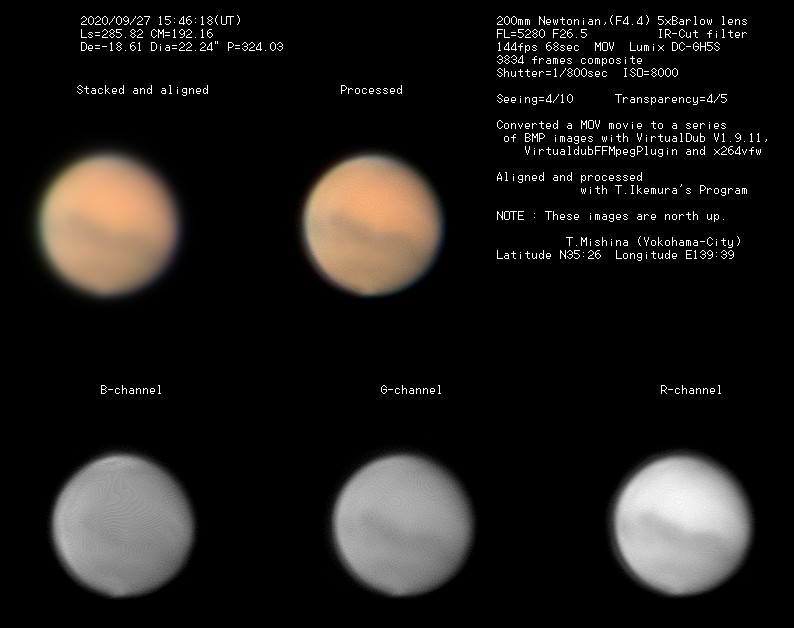 ≪神奈川県 横浜市 三品利郎≫[Toshirou.Mishina:Kanagawa Japan]
≪神奈川県 横浜市 三品利郎≫[Toshirou.Mishina:Kanagawa Japan]
Conditions were far from good with high altitude cirrus clouds,
haze and jet stream speeding around 20 to 25 m/s more favorable to infrared imaging again.
Using Mars Albedo Features classic nomenclature,bright Ophir and Sinai contrasting with darker Juventae Fons,
Aurorae Sinus,Protei〓Regio and Coprates. Dark border of Mare Erythraeum and Bosporus contrasting with brighter Thaumasia.
As always,great color variation in this Martian hemisphere.
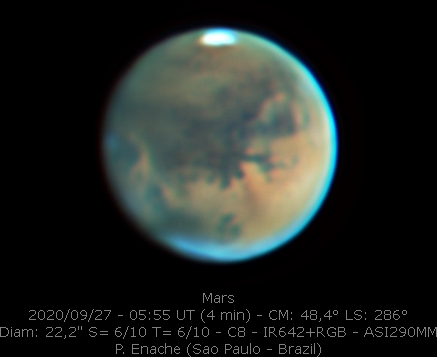
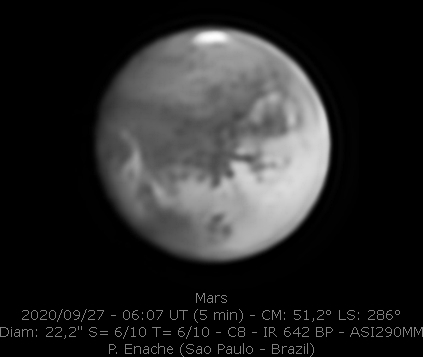 [Pericles Enache,Sao Paulo,Brazil]
[Pericles Enache,Sao Paulo,Brazil]
久しぶりの晴れ間でしたが、シーイングはダメでした。
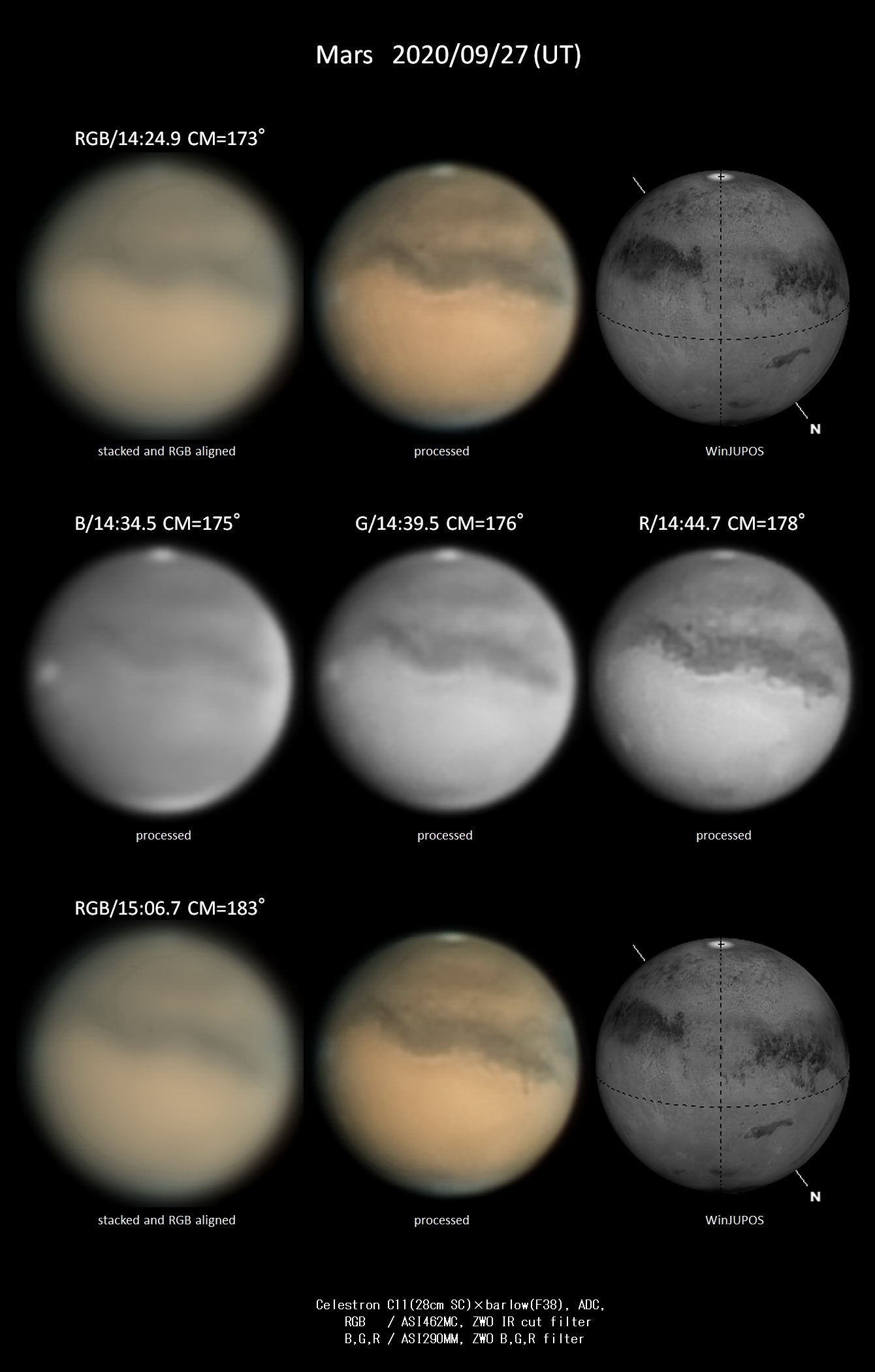 ≪大阪府 枚方市 井上 修≫[Osamu Inoue. Hirakata-shi,Osaka,Japan]
≪大阪府 枚方市 井上 修≫[Osamu Inoue. Hirakata-shi,Osaka,Japan]
Hi all,here's an image of Mars from this morning through a 750nm longpass filter.
The seeing was poor with strong jetstream blurring,
5 images captured between 1544utc and 1630utc were combined to get this result.
Olympus Mons can just be seen setting on the right hand side.
The large bright region of Elysium is prominent at the top of the image.
 [Anthony Wesley,Murrumbateman Australia]
≪アンソニ オーストラリア≫
[Anthony Wesley,Murrumbateman Australia]
≪アンソニ オーストラリア≫
雲の往来もあり、加えて結露が酷い。
ターミネーターにアルシア、パボニウスが見られる。オリンポスも見えるが雲が懸かっているのはアルシア付近だけである。
BE-410では地表の模様との対応は認められない。ただ、ワルハラのみが地表の明暗と対応している。
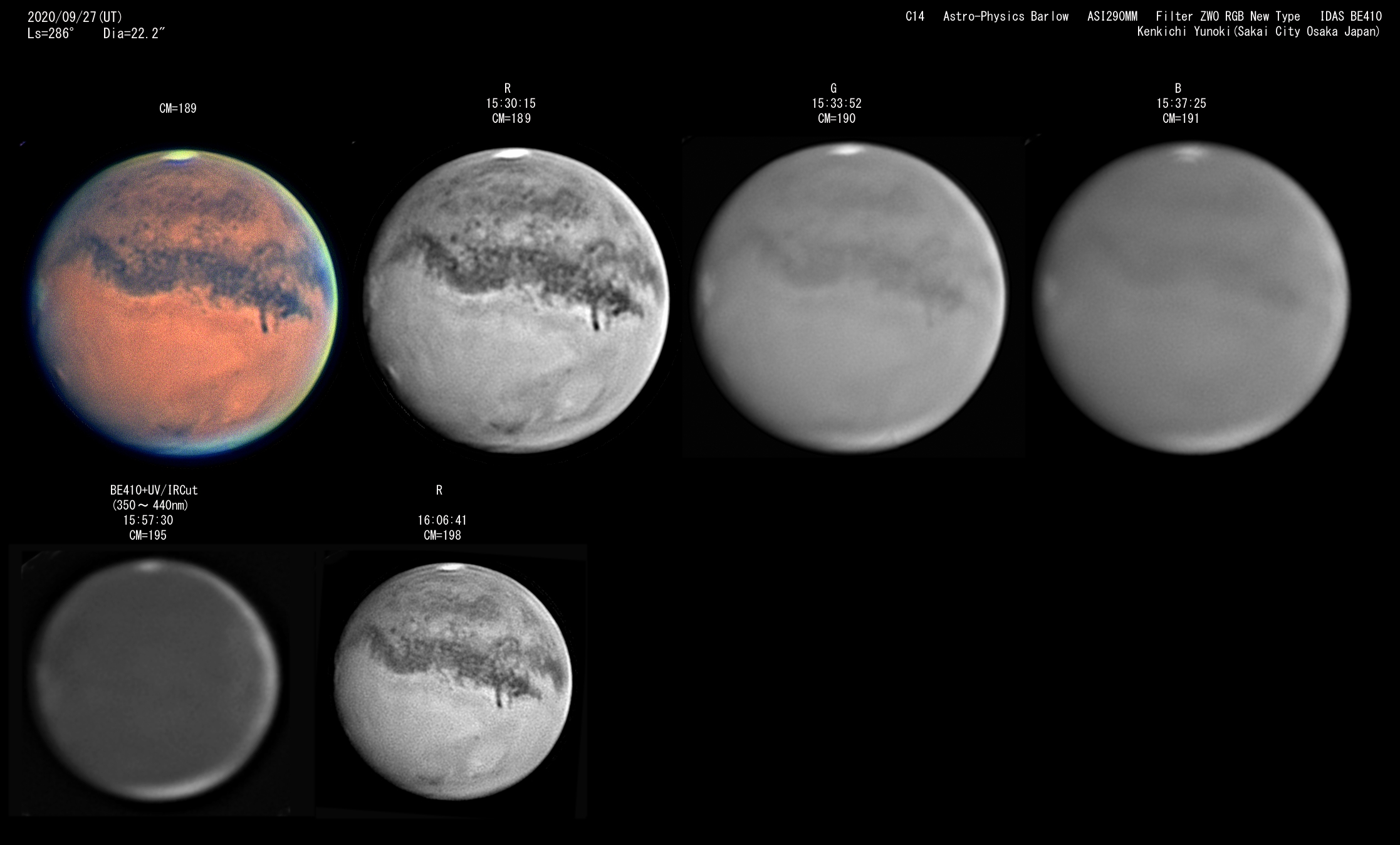 [Kenkichi Yunoki (Sakai City,Japan)]
≪大阪府 堺市 柚木健吉≫
[Kenkichi Yunoki (Sakai City,Japan)]
≪大阪府 堺市 柚木健吉≫
1週間ぶりに晴れてくれたものの、シーイングが悪すぎてピント合わせ困難でした。
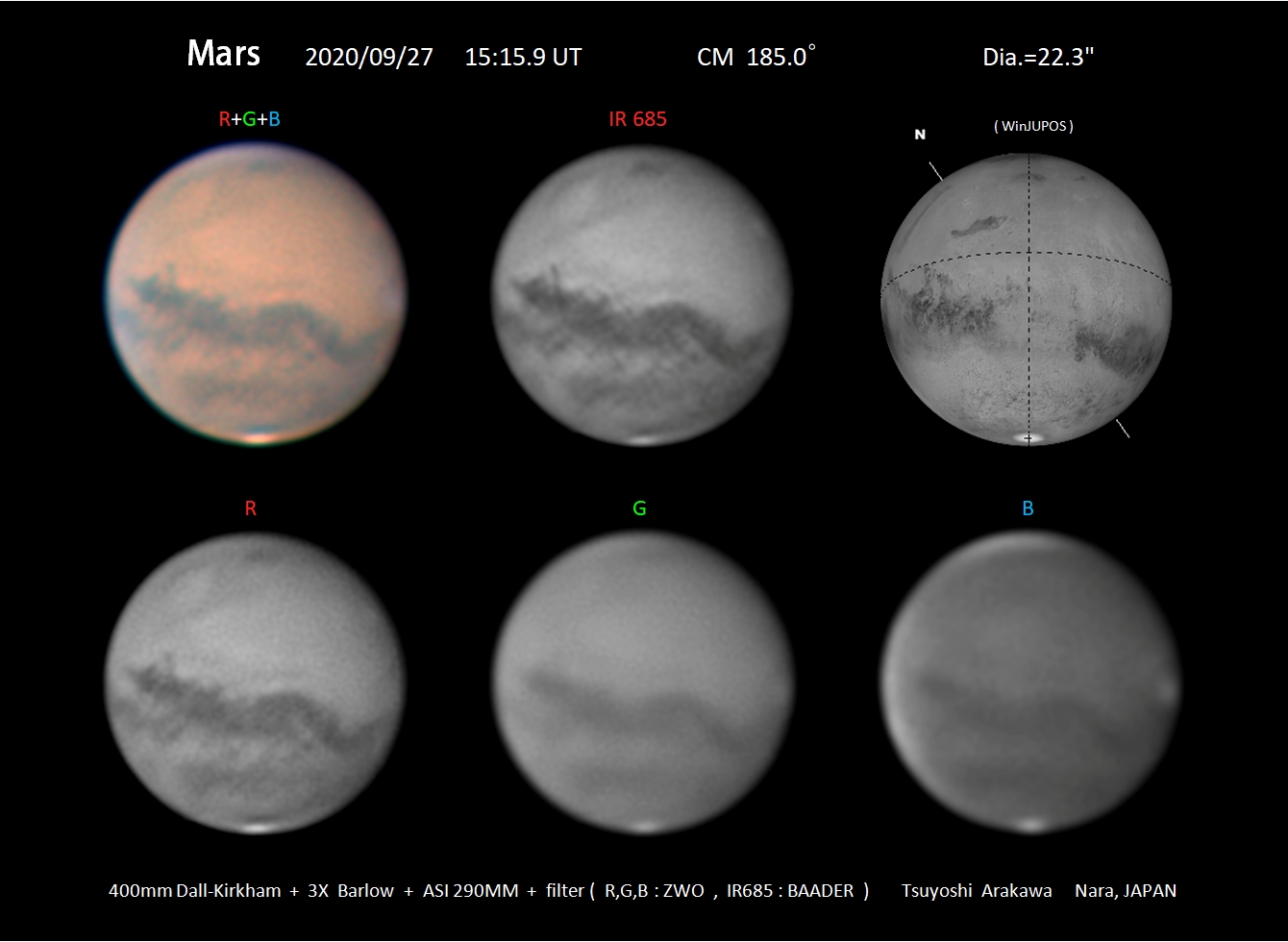
 ≪奈良県奈良市 荒川 毅≫[Tsuyoshi Arakawa:Nara Japan]
≪奈良県奈良市 荒川 毅≫[Tsuyoshi Arakawa:Nara Japan]
Somewhat improved (though still not ideal) seeing in Canberra last night
and a lack of cloudy interludes meant it was worth swapping the colour camera for the mono camera.
Mars here is seen with a much reduced polar cap,with clouds over the Tharsis Mountains,while Olympus
- apparently unclouded from my inspection of the blue channel - glimmers at the terminator.
 [Mark Lonsdale : [Canberra,Australia]
[Mark Lonsdale : [Canberra,Australia]
久々の晴れ間、しかし木星は、グニャグニャ、北風もピューピュウ、木星はあきらめたが。
火星を見てみると、思ったよりよく見える。しかし途中からseeing悪化。
へスペリアから西は、白く淡い、画像ではしっかり写っているので、朝霧のようなものか?
南極冠は、小さくなった。 視直径も22.3”でほぼ最大、画像も丸く見えるようになった。
 ≪三重県熊野市 畑中明利≫[Akitoshi Hatanaka:Kumano Mie Japan]
≪三重県熊野市 畑中明利≫[Akitoshi Hatanaka:Kumano Mie Japan]
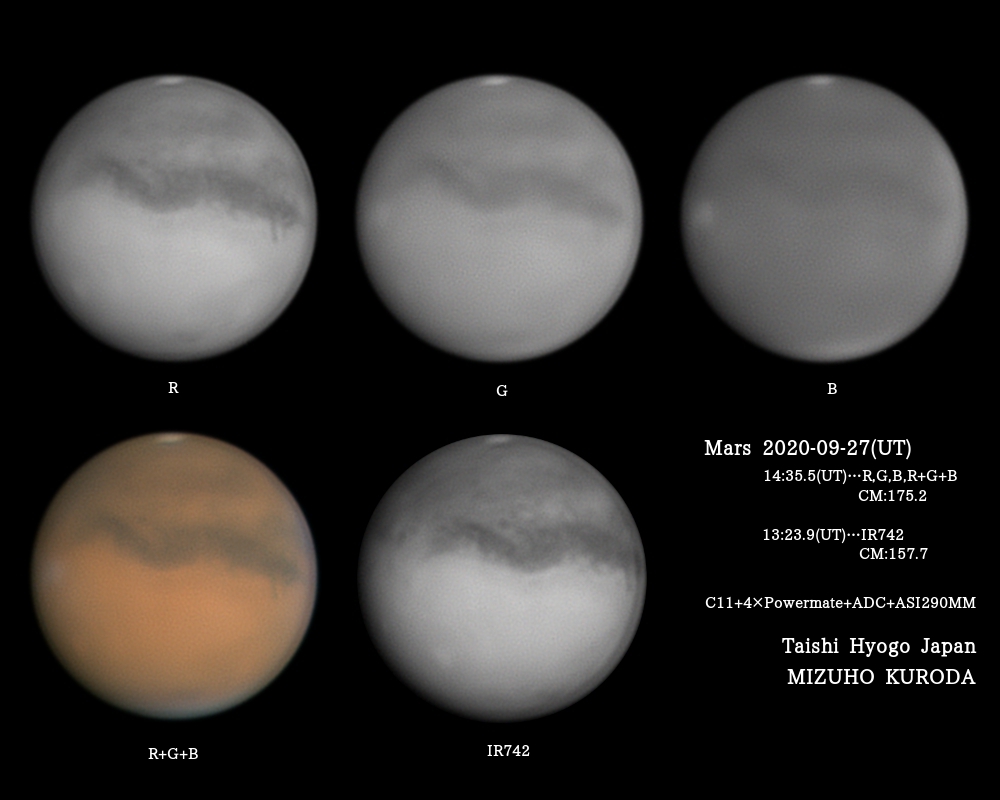 ≪黒田瑞穂 : 兵庫県 太子町≫[Mizuho Kuroda : Taishi Hyogo Japan]
≪黒田瑞穂 : 兵庫県 太子町≫[Mizuho Kuroda : Taishi Hyogo Japan]
Here are two LRGB images showing Tharsis clouds and preceding limb clouds in trying conditions.
Seems like this week will have a weaker jet stream,so will aim for some true RGB images.
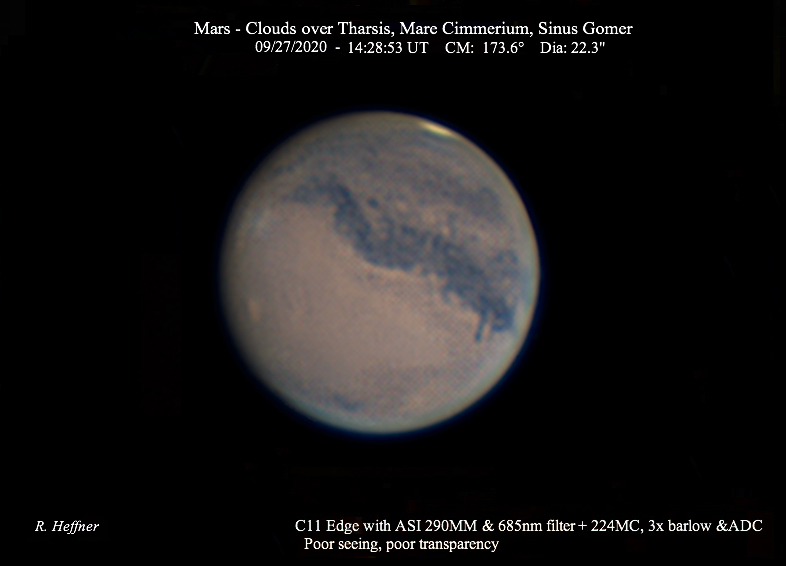
 [Robert Heffner:Osaka,Japan]
[Robert Heffner:Osaka,Japan]
久しぶりに晴れたのですが、雲が多く、雲間での撮影で、十分な撮影ができませんでした。
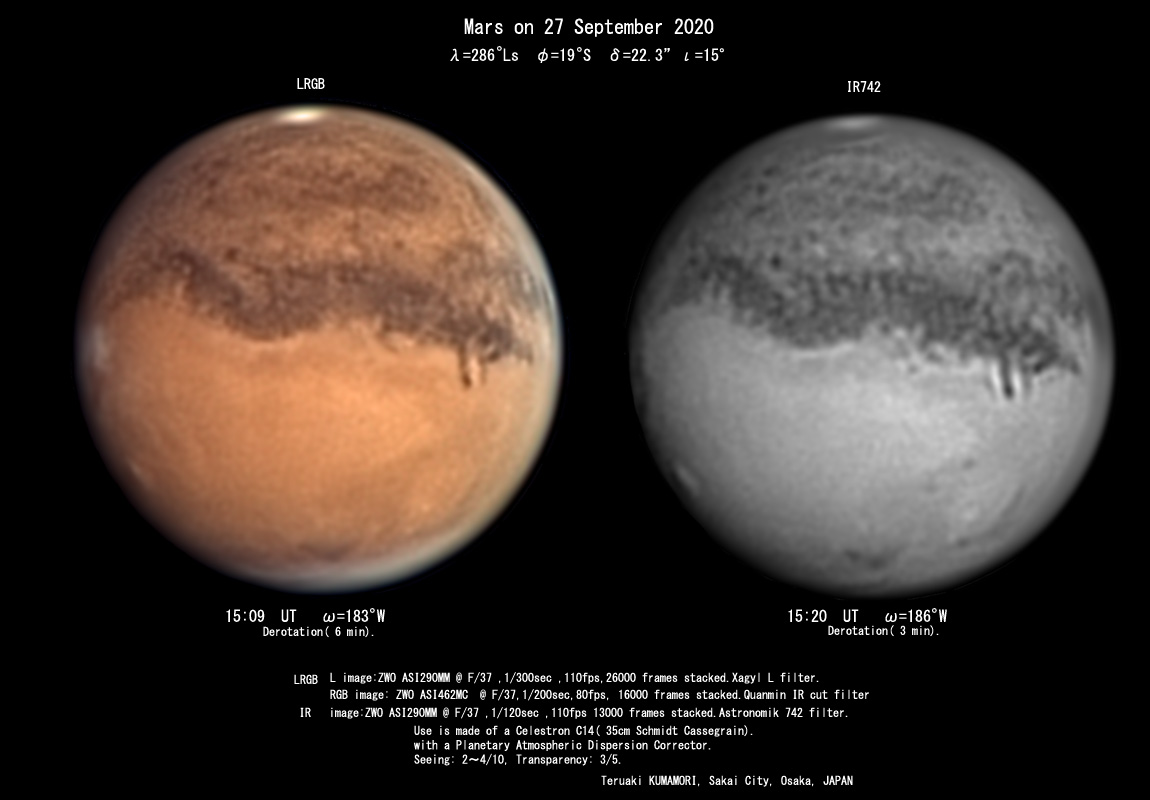 ≪大阪府堺市 熊森照明≫[Teruaki Kumamori:Ohsaka Japan]
≪大阪府堺市 熊森照明≫[Teruaki Kumamori:Ohsaka Japan]

[Du Jin Kim,South Korea]
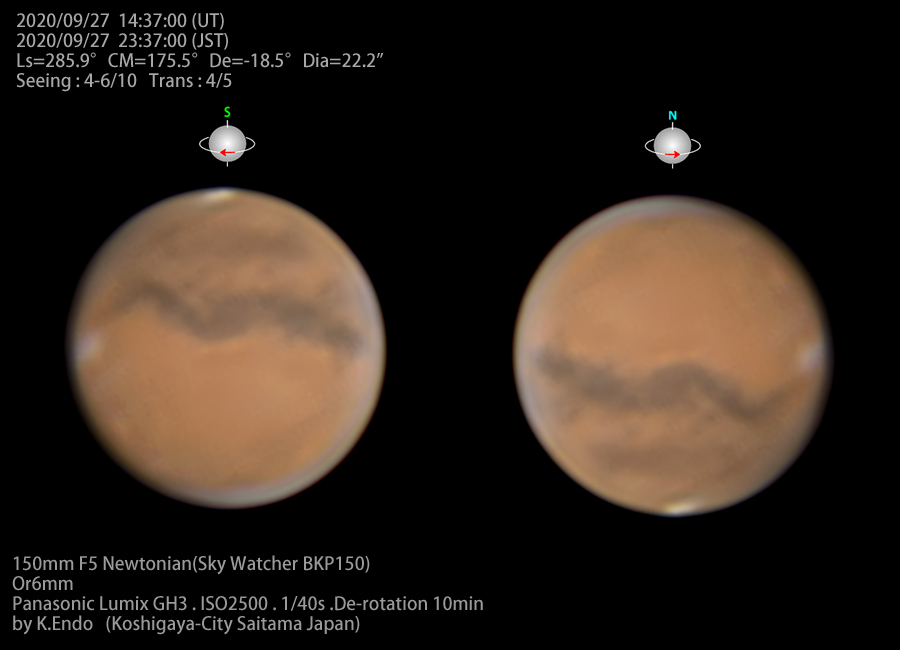 ≪埼玉県越谷市 遠藤宏次≫[Koji Endo : Saitama Japan]
≪埼玉県越谷市 遠藤宏次≫[Koji Endo : Saitama Japan]
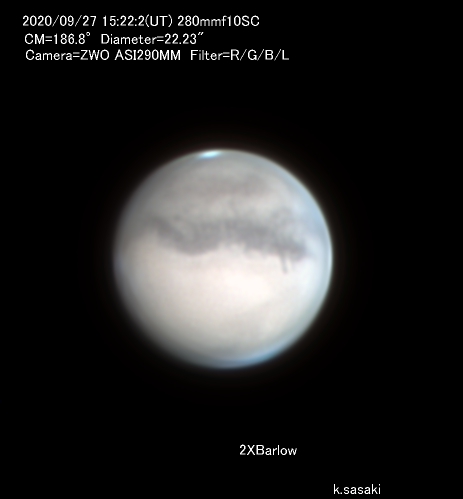 [K.Sasaki:Ohsaki-City Miyagi-Prefecture Japan]
≪宮城県大崎市 佐々木一男≫
[K.Sasaki:Ohsaki-City Miyagi-Prefecture Japan]
≪宮城県大崎市 佐々木一男≫
|
Christofer Mauricio Baez Jimenez |
12 images derotated using WinJUPOS.
 [Christofer Mauricio Baez Jimenez :Santo Domingo,Dominican Republic.]
[Christofer Mauricio Baez Jimenez :Santo Domingo,Dominican Republic.]
under cristalclear Sky and averidge Seeing.

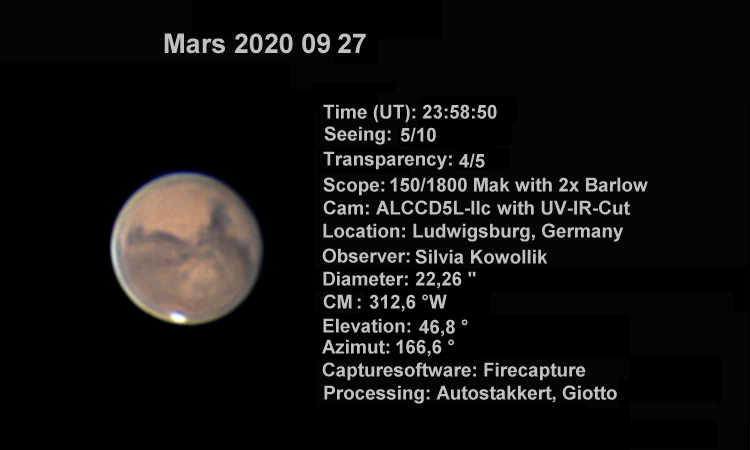 [Silvia Kowollik Ludwigsburg,Germany]
[Silvia Kowollik Ludwigsburg,Germany]
南極冠がずいぶん小さくなり、その周辺が黒々とてきた感があり、北半球では Olypia 山が大きく存在感があり、
Tharsis 地方 の Arsia 山をはじめとする三山もくっきりと判明できる。
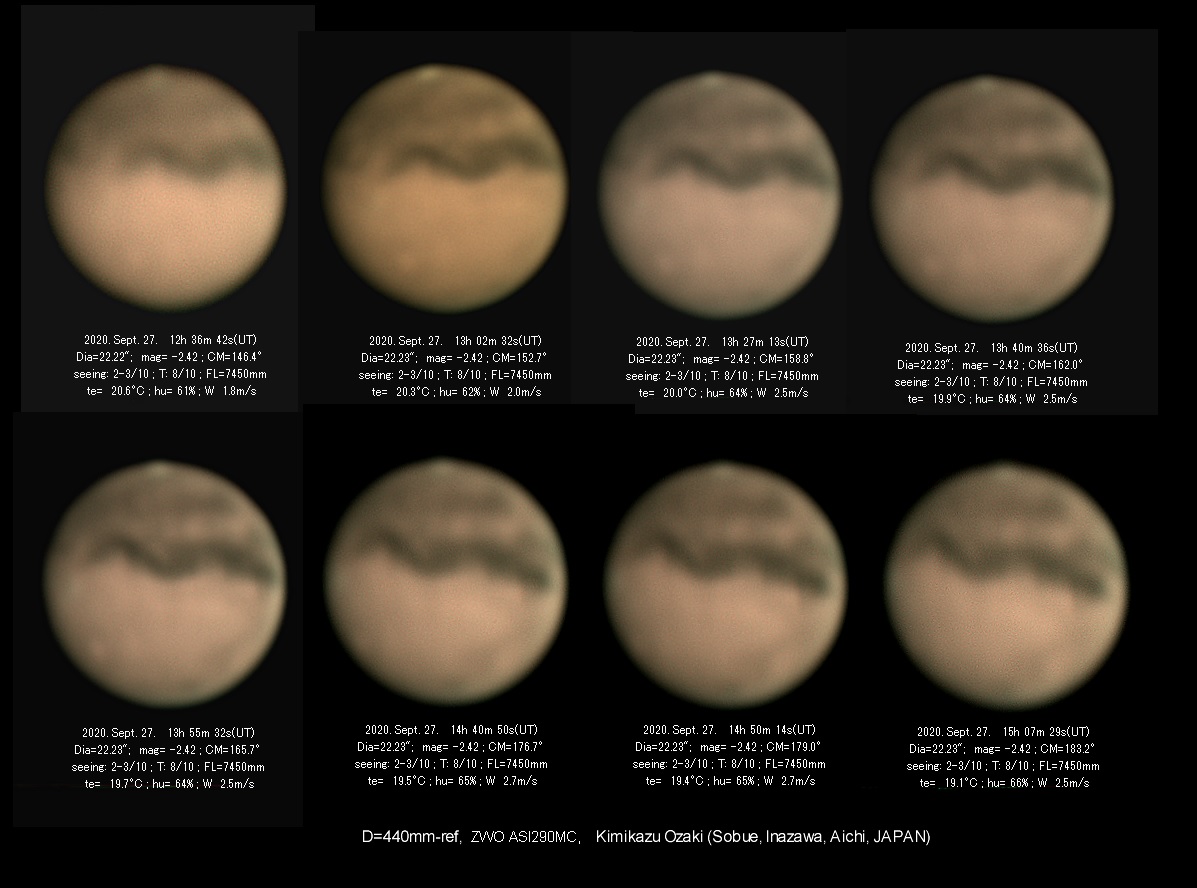 [Ki.Ozaki,Sobue Inazawa Aichi JAPAN]
≪愛知県稲沢市祖父江町 尾崎公一≫
[Ki.Ozaki,Sobue Inazawa Aichi JAPAN]
≪愛知県稲沢市祖父江町 尾崎公一≫
The seeing was average due to the unsettled weather conditions;
the weekend's high wind having only just abated.
However,I was still able to get a good view in the better moments.
Hellas was〓bright at mid disc,with Zea Lacus obvious in its southern regions.
Syrtis Major was prominent and well defined,
however I felt its Northern tip was soft,perhaps obscured by the NPH.
The Mist on the Western limb extended well onto the disc just south of the equator,
obscuring a little of Sinus Sabaeus,and Pandorae Fretum.
I also felt there was a little hint of greyish mist at the evening terminator over Mares Tyrrhenum and Cimmerium.
The SPC did not show any fragmentation,although conditions didn't allow definitive scrutiny.
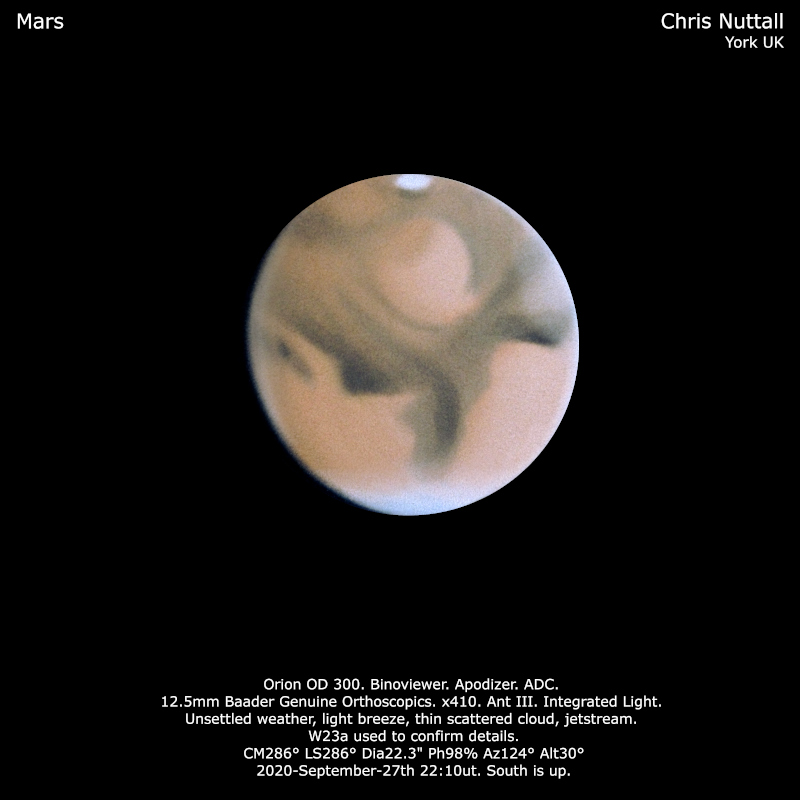 [Chris Nuttall : York,UK]
[Chris Nuttall : York,UK]
Fairly good seeing here on the 27th September,the attached is 12.5 minutes worth of data,
5 files merged using Winjupos,each file the best 4,000 of 22,000 frames,resized 150%.
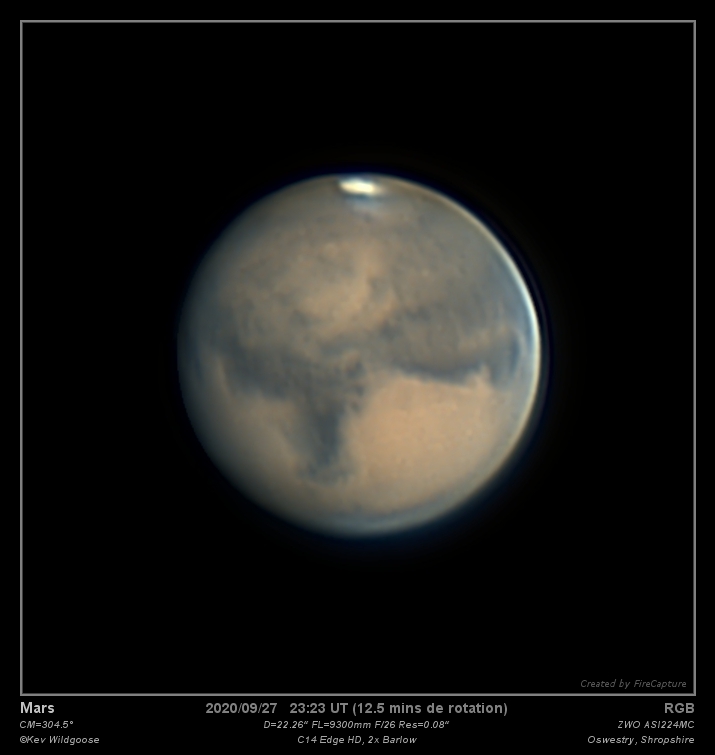 [Kev Wildgoose:Oswestry,UK]
[Kev Wildgoose:Oswestry,UK]
High turbulence ( jet stream 29m/s,and high temperature,camera sensor up to 32* C during the capture)
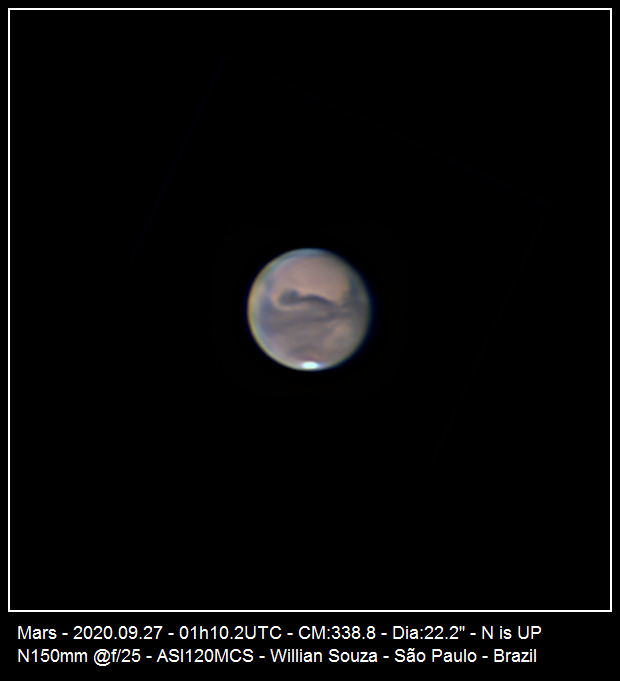 [Willian Souza : Sao Paulo,Brazil]
[Willian Souza : Sao Paulo,Brazil]
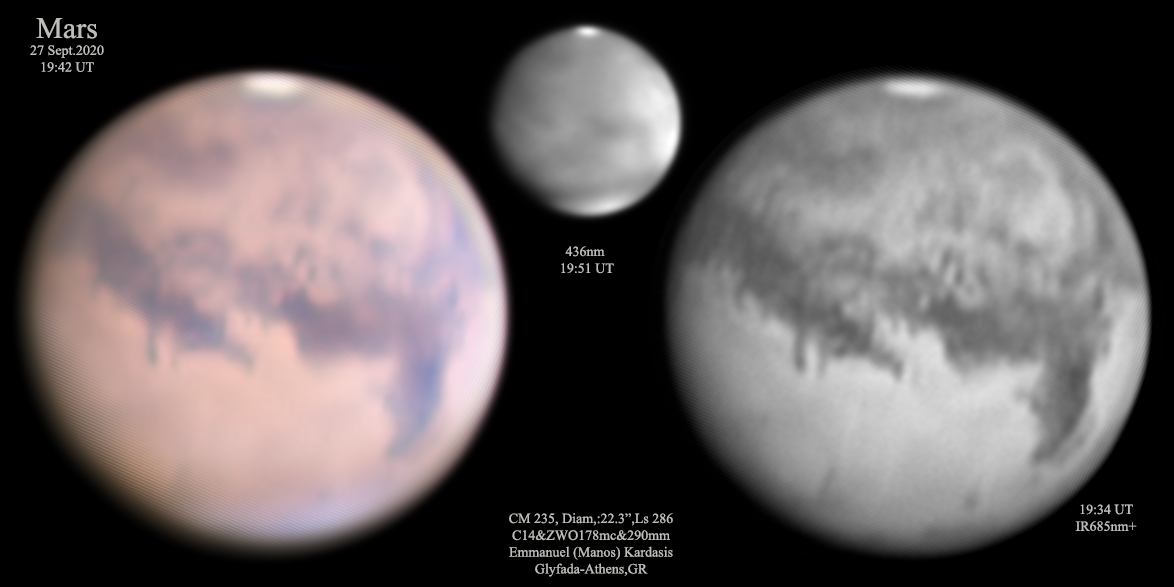 [Manos Kardasis,Glyfada-Athens;Greece]
《カーダシス マノス:ギリシャ アテネ》
[Manos Kardasis,Glyfada-Athens;Greece]
《カーダシス マノス:ギリシャ アテネ》
 [Vlamir da Silva Junior : Sao Paulo,Brazil]
[Vlamir da Silva Junior : Sao Paulo,Brazil]
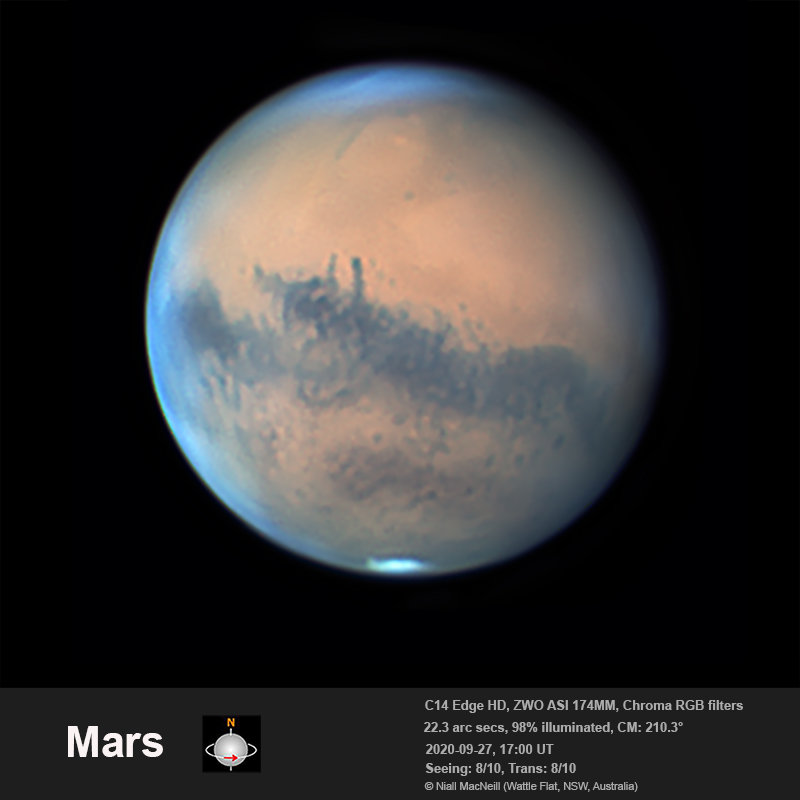 Update at 2021/12/09
I don’t know whether Andy Casely is more persistent in trying to dodge the clouds than I am,
but hats off to him for capturing images given the overall inclemency of the weather here on the eastern Seaboard of Australia at the moment.
I returned again to my Mars data from 2020, knowing there were some data that I didn't process.
In fact on the 27th of September I did a long series of runs, but only ended up processing the data from later in the session,
as it looked the best. However, on review, there were also some nice conditions early on that evening.
This also gave me an opportunity to see whether I could use the rotation feature in WinJUPOS to mitigate the Mars Edge Rind Effect.〓
The〓first image is the one I did process from that run, with a timestamp of 17:00UT.〓 It has already been uploaded to PVOL and Alpo Japan.
In that image, Elysium Mons, the extinct volcano, is at the Central Meridian to the north (up).
It is the slightly ruddy protuberance, surrounded by a lighter coloured plain.
Sinus Gomer is to the south, below it in the image, like two fingers of dark paint dripping upwards.
The second image is one I just processed from an earlier run that night at 14:43UT.
Notice the beautiful white cloud around the Tharsis Shield Volcanoes at the terminator, with Olympus Mons bulging prominently to their north.
On the other limb at about the same latitude is Elysium Mons, which was rotating into view,
to be central as seen in the first image 2+ hours later.
The Mars Edge Rind Effect can be readily seen at the lower left limb as the dark ring inside it.
This is a diffraction effect, where there is a sudden change from light to dark.
It is real and optical in nature, and therefore hard to get rid of. It does spoil many if not most images of Mars.
I did some work to mitigate the Mars Edge Rind Effect using WinJUPOS and Photoshop as described below.
In the〓3rd image, the artefact has been substantially removed. Please upload this one to PVOL and Alpo Japan.〓
I had wondered if, using the derotation function in WinJUPOS,
I could rotate the later image (17:00 UT) to the same timestamp of the earlier image(14:43 UT) and this was indeed possible.
The result is shown as the 4th image.
Since the edge here was rotated from the later image, where there was no such edge effect, the limb is clean and the detail goes right to the edge.
I brought this into a layer in Photoshop, under the 14:43UT image with the Edge Rind Effect (2nd image) and was able to replace the edge rind affected area with the clean limb.
The only problem was that near the limb there are blue-white clouds,
which show up when edge on, but not so much when we are looking perpendicularly through them at the more central longitudes of the planet.
I had to do some work to match colours and brightness, to retain the blue-white hue clearly present at the limb, due to these clouds.
This did complicate things, and is the reason some of the effect remains since I had to feather in the new area quite a bit so it blended seamlessly.
So yes there is still a touch of the diffraction effect but pleasingly it is vastly reduced. I hope you’ll agree.
Of course, it will not always〓be possible to get a good second image sufficiently displaced in time,
but where possible this technique can be used to reduce the impact of Mars Edge Rind Effect.
If the images are being acquired before opposition, as was the case here,
the image to be rotated will need to be captured after the main image. Conversely,
after opposition, the image to be rotated will need to be before the main image.
This is obviously〓because the hard limb edge moves from one side of the planet to the other over the opposition.
Update at 2021/12/09
I don’t know whether Andy Casely is more persistent in trying to dodge the clouds than I am,
but hats off to him for capturing images given the overall inclemency of the weather here on the eastern Seaboard of Australia at the moment.
I returned again to my Mars data from 2020, knowing there were some data that I didn't process.
In fact on the 27th of September I did a long series of runs, but only ended up processing the data from later in the session,
as it looked the best. However, on review, there were also some nice conditions early on that evening.
This also gave me an opportunity to see whether I could use the rotation feature in WinJUPOS to mitigate the Mars Edge Rind Effect.〓
The〓first image is the one I did process from that run, with a timestamp of 17:00UT.〓 It has already been uploaded to PVOL and Alpo Japan.
In that image, Elysium Mons, the extinct volcano, is at the Central Meridian to the north (up).
It is the slightly ruddy protuberance, surrounded by a lighter coloured plain.
Sinus Gomer is to the south, below it in the image, like two fingers of dark paint dripping upwards.
The second image is one I just processed from an earlier run that night at 14:43UT.
Notice the beautiful white cloud around the Tharsis Shield Volcanoes at the terminator, with Olympus Mons bulging prominently to their north.
On the other limb at about the same latitude is Elysium Mons, which was rotating into view,
to be central as seen in the first image 2+ hours later.
The Mars Edge Rind Effect can be readily seen at the lower left limb as the dark ring inside it.
This is a diffraction effect, where there is a sudden change from light to dark.
It is real and optical in nature, and therefore hard to get rid of. It does spoil many if not most images of Mars.
I did some work to mitigate the Mars Edge Rind Effect using WinJUPOS and Photoshop as described below.
In the〓3rd image, the artefact has been substantially removed. Please upload this one to PVOL and Alpo Japan.〓
I had wondered if, using the derotation function in WinJUPOS,
I could rotate the later image (17:00 UT) to the same timestamp of the earlier image(14:43 UT) and this was indeed possible.
The result is shown as the 4th image.
Since the edge here was rotated from the later image, where there was no such edge effect, the limb is clean and the detail goes right to the edge.
I brought this into a layer in Photoshop, under the 14:43UT image with the Edge Rind Effect (2nd image) and was able to replace the edge rind affected area with the clean limb.
The only problem was that near the limb there are blue-white clouds,
which show up when edge on, but not so much when we are looking perpendicularly through them at the more central longitudes of the planet.
I had to do some work to match colours and brightness, to retain the blue-white hue clearly present at the limb, due to these clouds.
This did complicate things, and is the reason some of the effect remains since I had to feather in the new area quite a bit so it blended seamlessly.
So yes there is still a touch of the diffraction effect but pleasingly it is vastly reduced. I hope you’ll agree.
Of course, it will not always〓be possible to get a good second image sufficiently displaced in time,
but where possible this technique can be used to reduce the impact of Mars Edge Rind Effect.
If the images are being acquired before opposition, as was the case here,
the image to be rotated will need to be captured after the main image. Conversely,
after opposition, the image to be rotated will need to be before the main image.
This is obviously〓because the hard limb edge moves from one side of the planet to the other over the opposition.
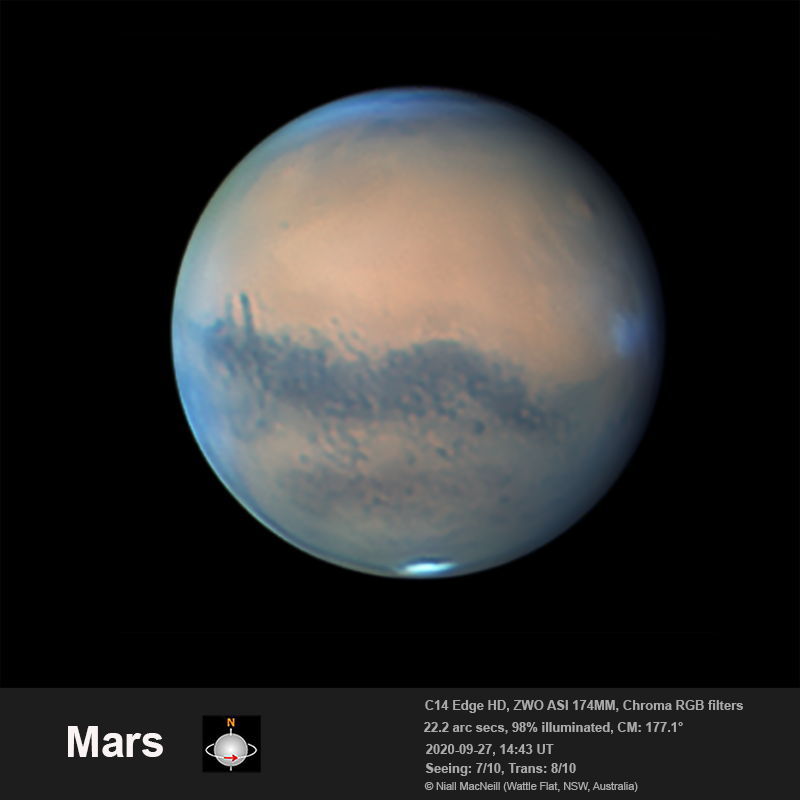
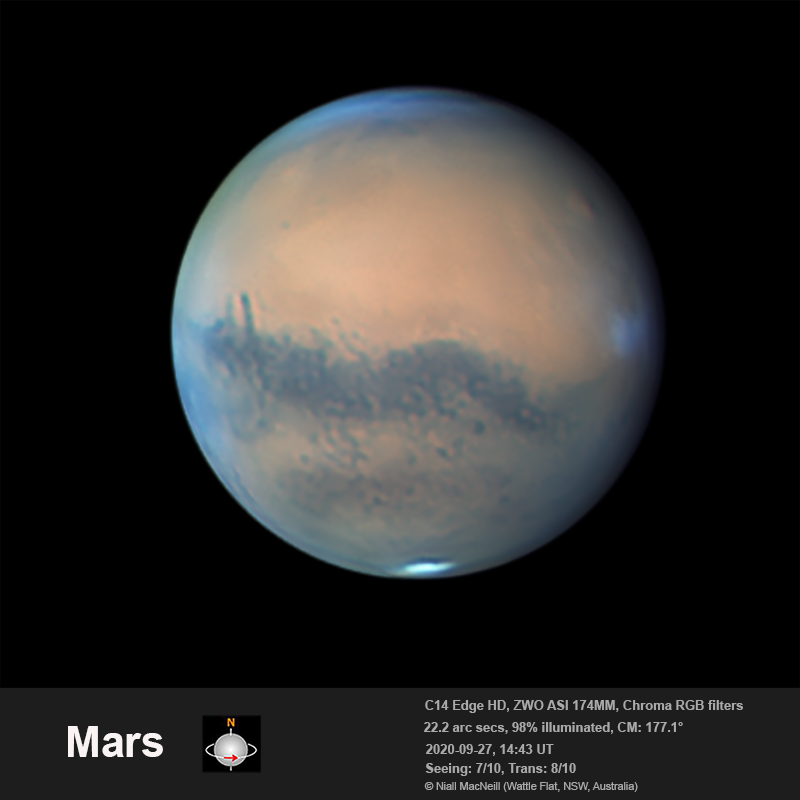
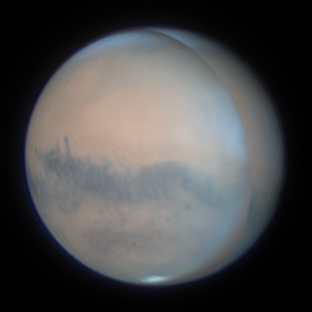 [Niall MacNeill : Wattle Flat,NSW,Australia]
[Niall MacNeill : Wattle Flat,NSW,Australia]


 ≪神奈川県 横浜市 三品利郎≫[Toshirou.Mishina:Kanagawa Japan]
≪神奈川県 横浜市 三品利郎≫[Toshirou.Mishina:Kanagawa Japan]
 [Pericles Enache,Sao Paulo,Brazil]
[Pericles Enache,Sao Paulo,Brazil] ≪大阪府 枚方市 井上 修≫[Osamu Inoue. Hirakata-shi,Osaka,Japan]
≪大阪府 枚方市 井上 修≫[Osamu Inoue. Hirakata-shi,Osaka,Japan] [Anthony Wesley,Murrumbateman Australia]
≪アンソニ オーストラリア≫
[Anthony Wesley,Murrumbateman Australia]
≪アンソニ オーストラリア≫ [Kenkichi Yunoki (Sakai City,Japan)]
≪大阪府 堺市 柚木健吉≫
[Kenkichi Yunoki (Sakai City,Japan)]
≪大阪府 堺市 柚木健吉≫
 ≪奈良県奈良市 荒川 毅≫[Tsuyoshi Arakawa:Nara Japan]
≪奈良県奈良市 荒川 毅≫[Tsuyoshi Arakawa:Nara Japan] [Mark Lonsdale : [Canberra,Australia]
[Mark Lonsdale : [Canberra,Australia] ≪三重県熊野市 畑中明利≫[Akitoshi Hatanaka:Kumano Mie Japan]
≪三重県熊野市 畑中明利≫[Akitoshi Hatanaka:Kumano Mie Japan] ≪黒田瑞穂 : 兵庫県 太子町≫[Mizuho Kuroda : Taishi Hyogo Japan]
≪黒田瑞穂 : 兵庫県 太子町≫[Mizuho Kuroda : Taishi Hyogo Japan]
 [Robert Heffner:Osaka,Japan]
[Robert Heffner:Osaka,Japan] ≪大阪府堺市 熊森照明≫[Teruaki Kumamori:Ohsaka Japan]
≪大阪府堺市 熊森照明≫[Teruaki Kumamori:Ohsaka Japan]
 ≪埼玉県越谷市 遠藤宏次≫[Koji Endo : Saitama Japan]
≪埼玉県越谷市 遠藤宏次≫[Koji Endo : Saitama Japan] [K.Sasaki:Ohsaki-City Miyagi-Prefecture Japan]
≪宮城県大崎市 佐々木一男≫
[K.Sasaki:Ohsaki-City Miyagi-Prefecture Japan]
≪宮城県大崎市 佐々木一男≫ [Christofer Mauricio Baez Jimenez :Santo Domingo,Dominican Republic.]
[Christofer Mauricio Baez Jimenez :Santo Domingo,Dominican Republic.]
 [Silvia Kowollik Ludwigsburg,Germany]
[Silvia Kowollik Ludwigsburg,Germany] [Ki.Ozaki,Sobue Inazawa Aichi JAPAN]
≪愛知県稲沢市祖父江町 尾崎公一≫
[Ki.Ozaki,Sobue Inazawa Aichi JAPAN]
≪愛知県稲沢市祖父江町 尾崎公一≫ [Chris Nuttall : York,UK]
[Chris Nuttall : York,UK] [Kev Wildgoose:Oswestry,UK]
[Kev Wildgoose:Oswestry,UK] [Willian Souza : Sao Paulo,Brazil]
[Willian Souza : Sao Paulo,Brazil] [Manos Kardasis,Glyfada-Athens;Greece]
《カーダシス マノス:ギリシャ アテネ》
[Manos Kardasis,Glyfada-Athens;Greece]
《カーダシス マノス:ギリシャ アテネ》 [Vlamir da Silva Junior : Sao Paulo,Brazil]
[Vlamir da Silva Junior : Sao Paulo,Brazil] Update at 2021/12/09
I don’t know whether Andy Casely is more persistent in trying to dodge the clouds than I am,
but hats off to him for capturing images given the overall inclemency of the weather here on the eastern Seaboard of Australia at the moment.
I returned again to my Mars data from 2020, knowing there were some data that I didn't process.
In fact on the 27th of September I did a long series of runs, but only ended up processing the data from later in the session,
as it looked the best. However, on review, there were also some nice conditions early on that evening.
This also gave me an opportunity to see whether I could use the rotation feature in WinJUPOS to mitigate the Mars Edge Rind Effect.〓
The〓first image is the one I did process from that run, with a timestamp of 17:00UT.〓 It has already been uploaded to PVOL and Alpo Japan.
In that image, Elysium Mons, the extinct volcano, is at the Central Meridian to the north (up).
It is the slightly ruddy protuberance, surrounded by a lighter coloured plain.
Sinus Gomer is to the south, below it in the image, like two fingers of dark paint dripping upwards.
The second image is one I just processed from an earlier run that night at 14:43UT.
Notice the beautiful white cloud around the Tharsis Shield Volcanoes at the terminator, with Olympus Mons bulging prominently to their north.
On the other limb at about the same latitude is Elysium Mons, which was rotating into view,
to be central as seen in the first image 2+ hours later.
The Mars Edge Rind Effect can be readily seen at the lower left limb as the dark ring inside it.
This is a diffraction effect, where there is a sudden change from light to dark.
It is real and optical in nature, and therefore hard to get rid of. It does spoil many if not most images of Mars.
I did some work to mitigate the Mars Edge Rind Effect using WinJUPOS and Photoshop as described below.
In the〓3rd image, the artefact has been substantially removed. Please upload this one to PVOL and Alpo Japan.〓
I had wondered if, using the derotation function in WinJUPOS,
I could rotate the later image (17:00 UT) to the same timestamp of the earlier image(14:43 UT) and this was indeed possible.
The result is shown as the 4th image.
Since the edge here was rotated from the later image, where there was no such edge effect, the limb is clean and the detail goes right to the edge.
I brought this into a layer in Photoshop, under the 14:43UT image with the Edge Rind Effect (2nd image) and was able to replace the edge rind affected area with the clean limb.
The only problem was that near the limb there are blue-white clouds,
which show up when edge on, but not so much when we are looking perpendicularly through them at the more central longitudes of the planet.
I had to do some work to match colours and brightness, to retain the blue-white hue clearly present at the limb, due to these clouds.
This did complicate things, and is the reason some of the effect remains since I had to feather in the new area quite a bit so it blended seamlessly.
So yes there is still a touch of the diffraction effect but pleasingly it is vastly reduced. I hope you’ll agree.
Of course, it will not always〓be possible to get a good second image sufficiently displaced in time,
but where possible this technique can be used to reduce the impact of Mars Edge Rind Effect.
If the images are being acquired before opposition, as was the case here,
the image to be rotated will need to be captured after the main image. Conversely,
after opposition, the image to be rotated will need to be before the main image.
This is obviously〓because the hard limb edge moves from one side of the planet to the other over the opposition.
Update at 2021/12/09
I don’t know whether Andy Casely is more persistent in trying to dodge the clouds than I am,
but hats off to him for capturing images given the overall inclemency of the weather here on the eastern Seaboard of Australia at the moment.
I returned again to my Mars data from 2020, knowing there were some data that I didn't process.
In fact on the 27th of September I did a long series of runs, but only ended up processing the data from later in the session,
as it looked the best. However, on review, there were also some nice conditions early on that evening.
This also gave me an opportunity to see whether I could use the rotation feature in WinJUPOS to mitigate the Mars Edge Rind Effect.〓
The〓first image is the one I did process from that run, with a timestamp of 17:00UT.〓 It has already been uploaded to PVOL and Alpo Japan.
In that image, Elysium Mons, the extinct volcano, is at the Central Meridian to the north (up).
It is the slightly ruddy protuberance, surrounded by a lighter coloured plain.
Sinus Gomer is to the south, below it in the image, like two fingers of dark paint dripping upwards.
The second image is one I just processed from an earlier run that night at 14:43UT.
Notice the beautiful white cloud around the Tharsis Shield Volcanoes at the terminator, with Olympus Mons bulging prominently to their north.
On the other limb at about the same latitude is Elysium Mons, which was rotating into view,
to be central as seen in the first image 2+ hours later.
The Mars Edge Rind Effect can be readily seen at the lower left limb as the dark ring inside it.
This is a diffraction effect, where there is a sudden change from light to dark.
It is real and optical in nature, and therefore hard to get rid of. It does spoil many if not most images of Mars.
I did some work to mitigate the Mars Edge Rind Effect using WinJUPOS and Photoshop as described below.
In the〓3rd image, the artefact has been substantially removed. Please upload this one to PVOL and Alpo Japan.〓
I had wondered if, using the derotation function in WinJUPOS,
I could rotate the later image (17:00 UT) to the same timestamp of the earlier image(14:43 UT) and this was indeed possible.
The result is shown as the 4th image.
Since the edge here was rotated from the later image, where there was no such edge effect, the limb is clean and the detail goes right to the edge.
I brought this into a layer in Photoshop, under the 14:43UT image with the Edge Rind Effect (2nd image) and was able to replace the edge rind affected area with the clean limb.
The only problem was that near the limb there are blue-white clouds,
which show up when edge on, but not so much when we are looking perpendicularly through them at the more central longitudes of the planet.
I had to do some work to match colours and brightness, to retain the blue-white hue clearly present at the limb, due to these clouds.
This did complicate things, and is the reason some of the effect remains since I had to feather in the new area quite a bit so it blended seamlessly.
So yes there is still a touch of the diffraction effect but pleasingly it is vastly reduced. I hope you’ll agree.
Of course, it will not always〓be possible to get a good second image sufficiently displaced in time,
but where possible this technique can be used to reduce the impact of Mars Edge Rind Effect.
If the images are being acquired before opposition, as was the case here,
the image to be rotated will need to be captured after the main image. Conversely,
after opposition, the image to be rotated will need to be before the main image.
This is obviously〓because the hard limb edge moves from one side of the planet to the other over the opposition.


 [Niall MacNeill : Wattle Flat,NSW,Australia]
[Niall MacNeill : Wattle Flat,NSW,Australia] ALPO-Japan Latest
ALPO-Japan Latest